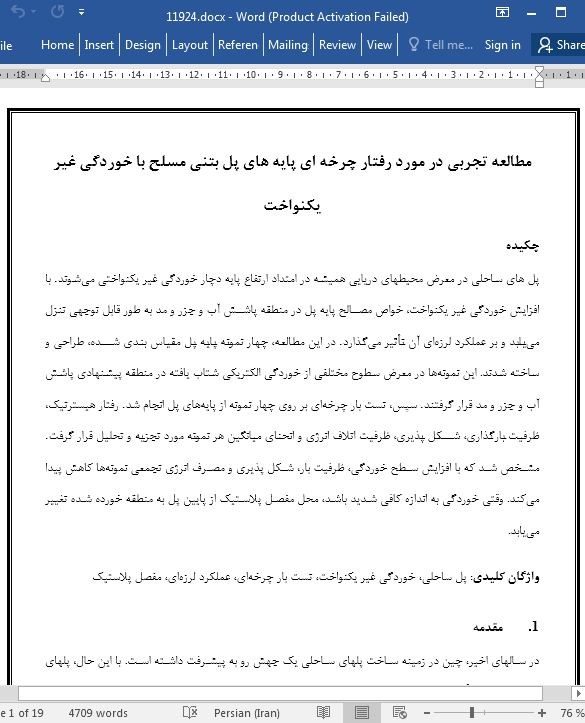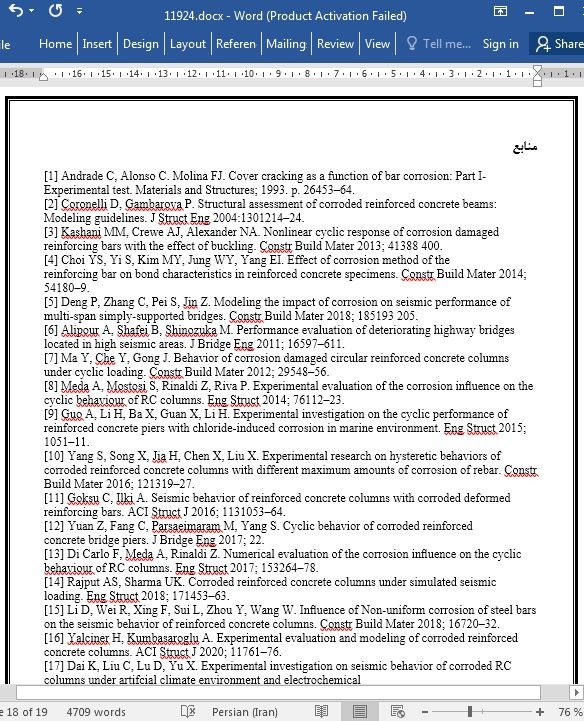
مطالعه تجربی در مورد رفتار چرخه ای پایه های پل بتنی مسلح با خوردگی غیر یکنواخت
چکیده
پل های ساحلی در معرض محیطهای دریایی همیشه در امتداد ارتفاع پایه دچار خوردگی غیر یکنواختی میشوند. با افزایش خوردگی غیر یکنواخت، خواص مصالح پایه پل در منطقه پاشش آب و جزر و مد به طور قابل توجهی تنزل مییابد و بر عملکرد لرزهای آن تأثیر میگذارد. در این مطالعه، چهار نمونه پایه پل مقیاس بندی شده، طراحی و ساخته شدند. این نمونهها در معرض سطوح مختلفی از خوردگی الکتریکی شتاب یافته در منطقه پیشنهادی پاشش آب و جزر و مد قرار گرفتند. سپس، تست بار چرخهای بر روی چهار نمونه از پایههای پل انجام شد. رفتار هیسترتیک، ظرفیت بارگذاری، شکل پذیری، ظرفیت اتلاف انرژی و انحنای میانگین هر نمونه مورد تجزیه و تحلیل قرار گرفت. مشخص شد که با افزایش سطح خوردگی، ظرفیت بار، شکل پذیری و مصرف انرژی تجمعی نمونهها کاهش پیدا میکند. وقتی خوردگی به اندازه کافی شدید باشد، محل مفصل پلاستیک از پایین پل به منطقه خورده شده تغییر مییابد.
1. مقدمه
در سالهای اخیر، چین در زمینه ساخت پلهای ساحلی یک جهش رو به پیشرفت داشته است. با این حال، پلهای ساحلی معمولاً برای دورههای زمانی قابل توجه در معرض محیطهای نامساعد قرار گرفتهاند. مشکل خوردگی آرماتوربندی فولادی ناشی از نفوذ کلرید، بارزتر شده است. نفوذ مداوم کلرید، سطح آرماتور (1)، مقاومت مصالح (2،3) و پیوند بین آرماتور و بتن (4) را کاهش میدهد. علاوه بر این، با توجه به اینکه بیشتر مناطق چین در معرض خطر زلزله هستند، پلهای ساحلی ممکن است با تهدید دوگانه شرایط نامساعد محیطی و زلزله مواجه شوند. پایههای پل اعضای اصلی باربر سازههای پل هستند، و تخریب شدید آنها باعث کاهش عملکرد لرزهای پلهای ساحلی میشود (5). برای اطمینان از ایمنی پلهای ساحلی، بررسی عملکرد لرزهای پایههای خورده شده و ارائه پیشنهادات مناسب برای طراحی و بازسازی پلهای ساحلی امری ضروری است (6).
4. نتیجه گیری
این مطالعه، خوردگی غیر یکنواخت پایههای پل ساحلی را در نظر گرفته است. چهار نمونه پایه پل با مقادیر مختلف خوردگی در ناحیه خوردگی پیشنهادی طراحی شدند و تست بار چرخهای انجام شد. نتیجه گیری اصلی با توجه به نتایج آزمایش، به شرح زیر است:
(1) سه نمونه پایه پل با استفاده از تست خوردگی الکتریکی شتاب یافته، دچار خوردگی شدند. با مقایسه میانگین درصد واقعی اتلاف جرم در هر نمونه با نرخ خوردگی هدف، تست خوردگی الکتریکی شتاب یافته میتواند نرخ خوردگی نسبتاً ایده آلی را در این تست بدست آورد.
(2) در مقایسه با نمونه خورده نشده، نمونههای خورده شده عملکرد هیسترزیس ضعیفی را نشان دادند که در آن بار پیک تا 23.3 % و شکل پذیری تا 45 % کاهش یافته بود. و مصرف انرژی تجمعی نیز از 16.9kN⋅m به 1.8kN⋅m تنزل یافته بود.
Abstract
Coastal bridges exposed to the marine environment always suffer from non-uniform corrosion along the pier height. As the non-uniform corrosion increase, the material properties of the pier in the splash and tidal zone deteriorates significantly, affecting the seismic performance of the pier. In this study, four scaled bridge pier specimens were designed and fabricated. These specimens were subjected to different level of electrical accelerated corrosion in the proposed splash and tidal zone. Then, the cyclic load tests were conducted on the four bridge pier specimens. The hysteretic behavior, loading capacity, ductility, energy dissipation capacity and mean curvature of each specimen were analyzed. It was found that with increasing corrosion level, the load capacity, ductility and cumulative energy consumption of the specimens decreased. When the corrosion was severe enough, the location of the plastic hinge will transfer from the pier bottom to the corroded zone.
1. Introduction
In recent years, China has made a developmental leap in coastal bridge construction. However, the coastal bridges are usually exposed to harsh environments for significant periods of time. The problem of steel reinforcement corrosion caused by chloride penetration has become more prominent. The continuous chloride penetration will reduce reinforcement area[1], material strength [2,3], and bond between reinforcement and concrete[4] . Moreover, Due to most areas of China are at risk of earthquakes, coastal bridges may face a dual threat of harsh environmental conditions and earthquakes. Piers are the primary loadbearing members for bridge structures, and the severe deterioration of piers will reduce the seismic performance of coastal bridges [5]. To ensure the safety of coastal bridges, it is necessary to investigate the seismic performance of corroded piers and provide appropriate suggestions for the design and retrofit of coastal bridges [6] .
4. Conclusions
This study considers the non-uniform corrosion of coastal bridge piers. Four pier specimens with different corrosion levels in the proposed corrosion zone were designed and cyclic load test was performed. Based on the test results, the main conclusions are as follows:
(1) Three bridge pier specimens were corroded using the electrical accelerated corrosion test. Comparing the actual average mass loss percentage of the reinforcements of each specimen with the target corrosion rate, the electric accelerated corrosion test can obtain relatively ideal test corrosion rate.
(2) Comparing with the uncorroded specimen, the corroded specimens showed a poor hysteresis performance, of which the peak load decreased by up to 23.3% while the ductility down to 45% and the accumulated energy consumption decreased from 16.9kN⋅m to 1.8kN⋅m.
چکیده
1. مقدمه
2. برنامه آزمایشی
2.1. جزئیات نمونه
2.2. خوردگی الکتریکی شتاب یافته
2.3. تجهیزات آزمایشی و پروتکل بارگذاری
3. نتایج تجربی
3.1. مشاهده تجربی
3.2. منحنیهای هیسترتیک
3.3. ظرفیت و شکل پذیری مقاومت جانبی
3.4. اتلاف انرژی
3.5. انحنا
4. نتیجه گیری
منابع
Abstract
Keywords
1. Introduction
2. Experimental program
2.1. Specimen details
2.2. Electrical accelerated corrosion
2.3. Experimental setup and loading protocol
3. Experimental results
3.1. Experimental observation
3.2. Hysteretic curves
3.3. Lateral resistance capacity and ductility
3.4. Energy dissipation
3.5. Curvature
4. Conclusions
Declaration of Competing Interest
Acknowledgment
References
- اصل مقاله انگلیسی با فرمت ورد (word) با قابلیت ویرایش
- ترجمه فارسی مقاله با فرمت ورد (word) با قابلیت ویرایش، بدون آرم سایت ای ترجمه
- ترجمه فارسی مقاله با فرمت pdf، بدون آرم سایت ای ترجمه



